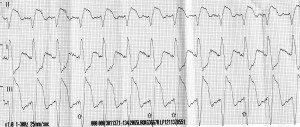Back to all articles
article
Updated Jun 1, 2022
Rhythm Strip Review
Updated Jun 1, 2022
Cardiology and Resuscitation


The paced rhythm is often simultaneously easy and complicated. You put on your 4-lead cables and take a look at the monitor. “What the heck is that?” may be your first response, then your brain kicks in and says, “Oh, it’s just a paced rhythm.” Hopefully this post will give you some more information to think about and consider the next time you see a paced rhythm in the field.
Things to Remember:
- Pacemakers can be single-chamber or dual-chamber
- Single-Chamber pacemakers pace only one chamber in the heart, either a ventricle or atria.
- Dual Chamber pacemakers will pace both an atria and a ventricle.
- Pacer spikes are the straight lines we see where the pacemaker is attempting to get the ventricles or atria to fire. Most machines these days will tell you where the pacer has fired with arrows on the top or bottom of the strip when you print it out.
- Pacemakers will operate in one of two modes:
- Fixed-Rate Pacemakers: These will continuously discharge at a rate that is preset by the physician. Usually 60-80 beats per minute.
- Demand Pacemakers: Discharges only when the patient’s heart rate drops to a rate that is under the initial rate programmed into the device by the Physician.
Studying for the NREMT?
We've helped over 200K+ students pass their NREMT, all for just $39/month
Need to recertify?
The easiest way to get your CE hours, 100% online.
- Dozens of courses and topics
- State-specific requirements
- We report to CAPCE in real time


